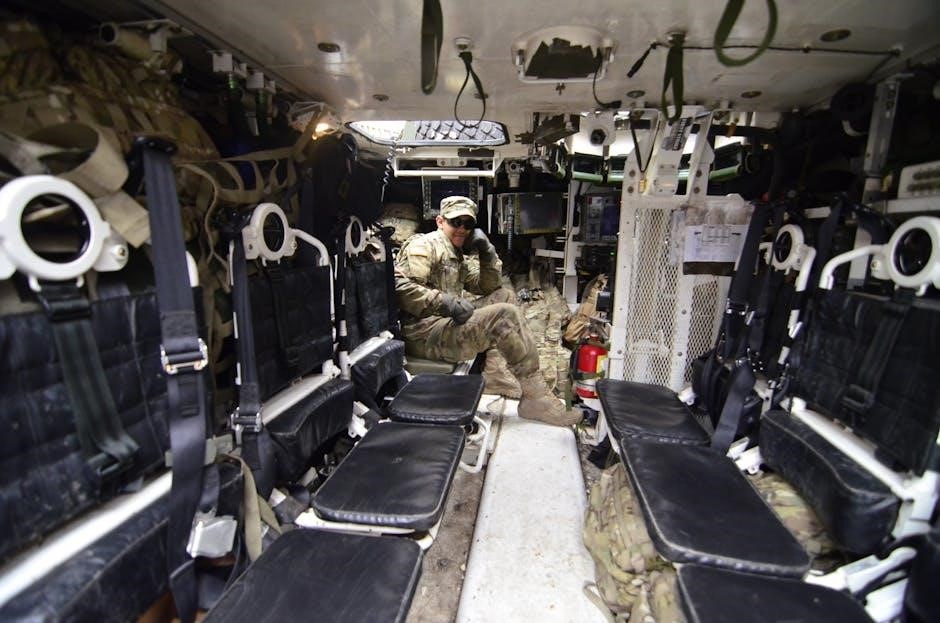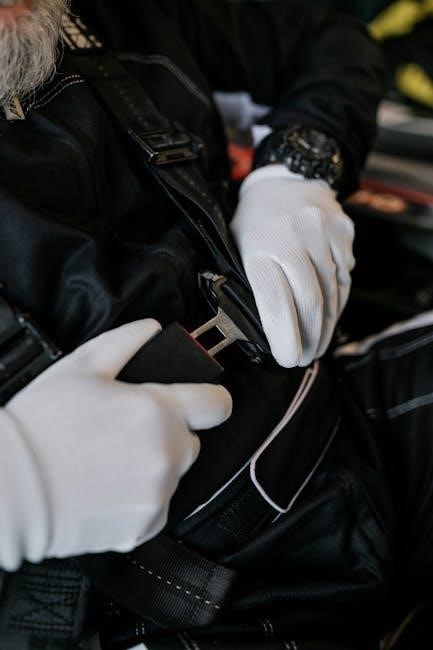Manual Restraint: A Comprehensive Overview
Manual restraint involves physical intervention to control a person’s movement, often in healthcare or security settings․ It’s a hands-on technique aimed at preventing harm or administering treatment․ This overview explores its definition, reasons for use, consequences, and guidelines, emphasizing safe application and de-escalation strategies to minimize risks;
Definition and Terminology
Manual restraint, at its core, involves direct physical contact by one or more individuals to restrict another person’s movement․ This action aims to control or immobilize the subject, primarily to prevent immediate harm to themselves or others․ It’s a hands-on intervention, distinguishing it from mechanical restraint, which employs devices like straps or belts․
The term “physical intervention” often encompasses manual restraint, referring to any direct physical contact used to limit movement․ This can range from guiding someone by the arm to more forceful techniques like holding or pinning them down․ In healthcare, manual restraint is sometimes used to administer necessary treatments when a patient is uncooperative or poses a risk․
Key terms associated with manual restraint include “de-escalation,” which refers to strategies used to calm a person before restraint becomes necessary, and “least restrictive intervention,” emphasizing the ethical obligation to use the mildest form of control possible․ Understanding these terms is vital for safe and responsible application of manual restraint techniques․
Furthermore, it’s essential to differentiate manual restraint from other forms of control, such as seclusion, which involves isolating a person in a room․ While both aim to manage behavior, manual restraint involves direct physical contact, while seclusion does not․
Reasons for Manual Restraint
Manual restraint is implemented in situations where an individual’s behavior poses an immediate risk of harm to themselves or others․ This could manifest as aggressive outbursts, self-injurious actions, or attempts to elope from a secure environment․ The primary goal is to ensure the safety of everyone involved, including the person being restrained․
In healthcare settings, manual restraint may be necessary to administer essential medical treatment when a patient is actively resisting․ This could include situations where medication needs to be given, or a medical procedure must be performed, and the patient’s lack of cooperation jeopardizes their well-being․ However, it’s crucial to prioritize de-escalation techniques before resorting to physical intervention․
Another justification for manual restraint is to prevent damage to property․ If an individual is engaging in destructive behavior, such as smashing objects or vandalizing a space, restraint may be used to stop them and minimize further destruction․
Furthermore, manual restraint can be employed to maintain order and security in environments where individuals are at risk of harming each other․ This is especially relevant in settings like mental health facilities or correctional institutions, where maintaining a safe and controlled environment is paramount․
Ultimately, the decision to use manual restraint should be based on a careful assessment of the situation, weighing the potential risks and benefits, and ensuring that it is the least restrictive option available․
Manual Restraint in Healthcare Settings
In healthcare environments, manual restraint is a complex intervention employed only when patients present an immediate danger to themselves or others․ Its application necessitates a careful balance between ensuring patient safety and upholding their rights and autonomy․ The decision to use manual restraint must be made by trained medical professionals following a thorough assessment of the patient’s condition and behavior․
Healthcare providers may utilize manual restraint to administer necessary medical treatments when a patient is actively resisting, and such resistance poses a significant threat to their health․ This could include situations requiring medication administration or essential medical procedures that the patient is unwilling or unable to cooperate with voluntarily․ However, it’s imperative that less restrictive alternatives, such as verbal de-escalation and medication, are exhausted first․
Protocols governing manual restraint in healthcare prioritize patient well-being and safety․ Staff members must be trained in proper restraint techniques to minimize the risk of physical or psychological harm․ Continuous monitoring of the patient’s vital signs, physical comfort, and emotional state is essential throughout the restraint period․
Documentation of the restraint incident is crucial, including the reasons for its use, the specific techniques employed, the patient’s response, and any adverse effects observed․ Regular reviews of restraint practices are necessary to ensure compliance with ethical and legal guidelines and to identify opportunities for improvement․
Manual Restraint in Security Settings
In security settings, manual restraint serves as a critical tool for managing individuals who pose an immediate threat to themselves, others, or the security of the environment․ Security personnel, ranging from law enforcement officers to private security guards, may employ these techniques to control aggressive behavior, prevent escape, or ensure compliance with lawful orders․

The use of manual restraint in security contexts often involves a graduated response, escalating from verbal commands to physical intervention only when necessary․ De-escalation techniques, such as active listening and clear communication, are crucial first steps in resolving conflicts peacefully․
Security professionals must receive comprehensive training in safe and effective restraint methods, emphasizing the importance of minimizing harm and respecting individual rights․ Training programs should cover legal considerations, ethical guidelines, and the potential risks associated with restraint techniques․

The specific techniques used will vary depending on the individual’s size, strength, and level of resistance․ Common methods include escort holds, handcuffing procedures, and takedown maneuvers․ It is imperative that security personnel maintain control while avoiding excessive force or unnecessary pain․
Post-incident protocols include thorough documentation of the event, including the reasons for restraint, the techniques used, and any injuries sustained․ This documentation serves as a record of accountability and may be subject to legal review․ Regular audits of restraint practices are essential to ensure compliance with policies and to identify areas for improvement․
Consequences for Patients
The consequences of manual restraint for patients can be multifaceted, encompassing both physical and psychological impacts․ While intended to ensure safety, the application of restraint can inadvertently lead to adverse outcomes if not executed with utmost care and adherence to established protocols․
Physically, patients may experience bruising, skin abrasions, or musculoskeletal injuries as a direct result of the restraint techniques employed․ The level of force used, the duration of restraint, and the patient’s underlying health conditions can all contribute to the severity of physical harm․
Psychologically, the experience of being restrained can be deeply traumatizing, eliciting feelings of fear, anxiety, and helplessness․ Patients may develop post-traumatic stress disorder (PTSD) or experience a decline in their overall mental well-being․ The loss of autonomy and control inherent in restraint situations can erode trust in caregivers and negatively impact the therapeutic relationship․
Furthermore, the use of manual restraint can contribute to feelings of stigmatization and isolation, particularly for individuals with pre-existing mental health conditions․ The perception of being treated as a threat can exacerbate symptoms and undermine efforts toward recovery․
It’s essential to acknowledge that the consequences of manual restraint can extend beyond the immediate incident, potentially affecting a patient’s long-term health and quality of life․ Healthcare providers must prioritize minimizing harm and providing compassionate care to mitigate these adverse effects․ Open communication, debriefing, and psychological support are crucial in helping patients process their experiences and regain a sense of safety and control․

Patient Rights, Legislation, and Guidelines
Patient rights, legislation, and guidelines surrounding manual restraint are crucial to protect vulnerable individuals and ensure ethical and safe practices․ These frameworks define the circumstances under which restraint may be used, emphasizing the importance of minimizing its application and prioritizing less restrictive alternatives․
Legislation often mandates that restraint be employed only as a last resort, when there is an imminent risk of harm to the patient or others․ It typically requires that a qualified healthcare professional authorize the use of restraint, documenting the rationale and the specific techniques employed․
Patient rights include the right to be free from unnecessary restraint, to be informed about the reasons for restraint, and to have the restraint discontinued as soon as the risk of harm subsides․ Patients also have the right to have their dignity and privacy respected during the restraint process․
Guidelines provide practical guidance on the safe and appropriate use of manual restraint, emphasizing the importance of de-escalation techniques, staff training, and ongoing monitoring of the patient’s physical and psychological well-being․ They often specify the types of restraint techniques that are permitted, as well as those that are prohibited due to their potential for harm․

Regular review and updates to legislation and guidelines are essential to reflect evolving best practices and to address any gaps or ambiguities․ Advocacy groups and professional organizations play a vital role in promoting patient rights and ensuring that these frameworks are effectively implemented and enforced․
Compliance with patient rights, legislation, and guidelines is not only a legal obligation but also a moral imperative for healthcare providers․ By adhering to these standards, professionals can uphold the dignity and safety of patients while minimizing the potential for harm associated with manual restraint․
De-escalation Techniques Prior to Manual Restraint
Before resorting to manual restraint, employing de-escalation techniques is paramount to diffuse potentially volatile situations and avoid physical intervention․ These techniques aim to reduce agitation and aggression by establishing communication, understanding the individual’s perspective, and creating a calmer environment․
Active listening is a cornerstone of de-escalation, involving attentive and empathetic engagement with the person’s concerns․ This includes acknowledging their feelings, validating their experience, and demonstrating a genuine desire to understand their point of view․ Non-verbal communication, such as maintaining a calm demeanor, using open body language, and avoiding confrontational stances, can also significantly impact the interaction․
Offering choices and providing a sense of control can empower the individual and reduce their resistance․ This may involve offering options related to their environment, activities, or care plan․ Clear and concise communication is essential, using simple language and avoiding jargon or ambiguous statements․
Creating a safe and supportive environment can also contribute to de-escalation․ This may involve reducing environmental stimuli, such as noise and bright lights, and ensuring that the individual has personal space․ Offering food, drink, or a quiet place to sit can also help to calm them․
It’s crucial to identify and address any underlying factors contributing to the agitation, such as pain, anxiety, or unmet needs․ Addressing these issues directly can often resolve the situation without the need for restraint;
Staff training in de-escalation techniques is essential to equip them with the skills and knowledge to effectively manage challenging situations․ This training should include role-playing scenarios, conflict resolution strategies, and techniques for managing their own emotions and reactions․
By prioritizing de-escalation techniques, healthcare professionals can create a more therapeutic environment, reduce the use of manual restraint, and promote patient safety and well-being․
Safe Usage Guidelines for Manual Restraint
When manual restraint is deemed absolutely necessary, strict adherence to safety guidelines is paramount to minimize the risk of harm to both the individual being restrained and the staff involved․ These guidelines encompass proper techniques, monitoring protocols, and documentation procedures․
Prior to initiating manual restraint, a thorough assessment of the individual’s physical and psychological state is crucial․ This includes identifying any pre-existing medical conditions, vulnerabilities, or potential risks that may influence the restraint procedure․ The least restrictive method should always be employed, and the rationale for restraint must be clearly documented․
Trained personnel should administer manual restraint, utilizing techniques that minimize pressure on vital areas, such as the chest and abdomen․ The individual’s airway must be continuously monitored to ensure adequate breathing․ Restraint positions that compromise circulation or cause undue discomfort should be avoided․
Throughout the restraint process, continuous monitoring of the individual’s physical and emotional well-being is essential․ This includes observing for signs of distress, such as changes in breathing, skin color, or level of consciousness․ Communication should be maintained with the individual, providing reassurance and explaining the reasons for the restraint․
Regular breaks from restraint should be provided whenever possible, allowing for movement and repositioning to prevent prolonged pressure on any one area․ Hydration and toileting needs should be addressed promptly․
Detailed documentation of the restraint event is crucial, including the reasons for restraint, the techniques used, the duration of restraint, and the individual’s response․ Any incidents or injuries that occur during the restraint process must be reported immediately․
Post-restraint debriefing with staff and the individual involved is essential to review the event, identify areas for improvement, and provide support․ Ongoing training and competency assessments for staff are critical to ensure safe and effective manual restraint practices․
Minimizing Harm During Manual Restraint
Minimizing harm during manual restraint requires a multi-faceted approach, prioritizing the safety and well-being of both the individual being restrained and the staff involved․ This involves not only the proper application of techniques but also a deep understanding of potential risks and the implementation of proactive strategies to mitigate them․
The selection of restraint techniques should always prioritize the least restrictive option necessary to ensure safety․ Techniques that involve excessive force, pressure on vital areas, or prolonged immobilization should be avoided․ Training in de-escalation techniques is crucial, empowering staff to resolve situations verbally and prevent the need for physical intervention whenever possible․
Continuous monitoring throughout the restraint process is essential․ Staff must be vigilant in observing for any signs of physical distress, such as changes in breathing, skin color, or level of consciousness․ Prompt intervention is necessary to address any emerging medical concerns․
Communication plays a vital role in minimizing harm․ Staff should maintain a calm and reassuring demeanor, explaining the reasons for restraint and providing updates on the situation․ Active listening and empathy can help de-escalate anxiety and promote cooperation․
Regular assessments of the individual’s physical and emotional state are necessary to ensure that the restraint is not causing undue harm․ Breaks from restraint should be provided whenever possible, allowing for movement and repositioning to prevent prolonged pressure on any one area․ Hydration and toileting needs should be addressed promptly․
Post-restraint debriefing is crucial for identifying areas for improvement and preventing future incidents․ Staff should reflect on the effectiveness of the techniques used and explore alternative strategies that may be less harmful․ Ongoing training and competency assessments are essential to ensure that staff are equipped with the knowledge and skills necessary to minimize harm during manual restraint․
Specific Manual Restraint Techniques

Specific manual restraint techniques vary depending on the context, the individual’s size and behavior, and the number of staff available․ A common technique involves a “Guiding Posture,” where staff gently guide the individual’s movements to prevent harm․ A “Guiding Hold” may be used to maintain control while minimizing discomfort․

The “Two-Handed Forearm Hold” provides a firmer grip, while the “Finger, Thumb & Wrist Hold” offers targeted control․ A “Cupped/Capped Fist Hold” can be used for redirection․ Some techniques involve holding an individual by the arms or shoulders to prevent them from moving or causing harm․
Other techniques involve safely bringing a person to the floor, such as in a seated intervention, using standing techniques for control․ When using any technique, the least restrictive method should always be the first choice․ Restraint must end when the threat of harm ends․
It is crucial that all staff are trained in the specific techniques they are authorized to use․ Training should include proper application, potential risks, and strategies for minimizing harm․ Staff must also be trained in de-escalation techniques to prevent the need for physical restraint whenever possible․
Techniques involving prone restraint (face down) should be avoided due to the risk of positional asphyxia․ Regular monitoring of the individual’s physical condition is essential throughout the restraint process․ Documentation of the techniques used, the reasons for their use, and the individual’s response is also necessary․

Manual Restraint Techniques for Animals
Manual restraint techniques for animals are crucial for veterinary care, research, and safety․ These techniques vary greatly depending on the species, size, and temperament of the animal․ For small animals like mice and rats, a common method is the “scruff hold,” where the loose skin on the back of the neck is gently grasped to immobilize the animal․
Another technique for rodents involves using a cloth as a simple restraining device, providing a hiding place to reduce anxiety․ For dogs, restraint can involve a muzzle to prevent biting, or physical holds to limit movement during examinations or procedures․ Cats often require a different approach, using techniques that minimize stress and fear․
For larger animals like horses, restraint may involve halters, lead ropes, or stocks to restrict movement while allowing access for veterinary care․ In non-human primates, manual restraint is often performed by two people to ensure the animal’s safety and the handler’s security․ The Camilla Method, using a cloth for restraint, can be adapted for various species to administer injections more easily․
It is essential that individuals performing animal restraint are properly trained in the specific techniques for each species․ Training should include understanding animal behavior, minimizing stress, and preventing injury to both the animal and the handler․ The goal is to use the least restrictive method possible while ensuring safety and cooperation․
Techniques must be adapted based on individual animal temperament and behavior․ Always monitor the animal’s condition and adjust techniques as needed to avoid causing undue stress or harm․
Staff Training in Manual Restraint Techniques

Comprehensive staff training in manual restraint techniques is paramount for ensuring the safety of both staff and individuals requiring restraint․ Training programs should cover a range of essential topics, including de-escalation strategies, communication skills, and specific restraint methods appropriate for various situations․
A key component of training is understanding the legal and ethical considerations surrounding manual restraint, emphasizing patient rights and the importance of using the least restrictive intervention necessary․ Staff should be trained to recognize signs of distress and medical emergencies, and to respond appropriately․

Hands-on practice is vital, allowing staff to develop proficiency in applying restraint techniques safely and effectively; Training should include scenarios that simulate real-world situations, enabling staff to make informed decisions under pressure․ It is crucial to focus on techniques that minimize the risk of injury to both the individual being restrained and the staff members involved․
Regular refresher courses are essential to maintain competency and to update staff on best practices and any changes in policy or legislation․ These courses should also address the importance of documentation and reporting of restraint incidents․
Moreover, training should incorporate a focus on post-incident debriefing, allowing staff to reflect on their actions, identify areas for improvement, and receive support following potentially stressful events; Effective training empowers staff to use manual restraint as a last resort, prioritizing de-escalation and alternative strategies whenever possible․ Furthermore, staff should be trained to know different types of restraints․
Reporting and Debriefing After Manual Restraint Incidents
Comprehensive reporting and thorough debriefing are critical components of responsible manual restraint practices․ Following any incident involving manual restraint, a detailed report should be completed promptly, accurately documenting the events leading up to the restraint, the specific techniques used, and the duration of the intervention․
The report should include information about the individual’s behavior, any injuries sustained by either the individual or staff members, and any alternative strategies that were attempted before resorting to restraint․ All staff involved in the incident should contribute to the report, ensuring a comprehensive and objective account․
Debriefing sessions should be conducted as soon as possible after the incident, providing a safe and supportive environment for staff to discuss their experiences, emotions, and any concerns they may have․ The debriefing process should involve a review of the incident, focusing on what went well, what could have been done differently, and any lessons learned․
The purpose of debriefing is not to assign blame but rather to identify areas for improvement in policies, procedures, and training․ It also provides an opportunity for staff to receive support and address any psychological impact resulting from the incident․ Findings from reports and debriefing sessions should be used to inform ongoing training and to refine strategies for preventing future incidents of manual restraint․ The privacy of every person involved is essential and must be respected throughout the entire process․
Alternatives to Manual Restraint
Prioritizing alternatives to manual restraint is crucial in fostering a safer and more therapeutic environment․ These alternatives aim to address the underlying causes of distress and prevent escalation to the point where restraint seems necessary․ One key approach is proactive communication, involving active listening and empathetic dialogue to understand the individual’s needs and concerns․
Environmental modifications can also play a significant role, such as reducing sensory overload, providing a calm and quiet space, or removing potential triggers․ Offering choices and empowering individuals to make decisions about their care can enhance their sense of control and reduce anxiety․ Scheduled comfort rounds, where staff proactively check in with individuals, can help identify and address emerging issues before they escalate․
Sensory strategies, such as providing weighted blankets, calming music, or aromatherapy, can also be effective in managing distress․ Medication, when appropriate and prescribed by a qualified professional, can be used to manage acute symptoms of agitation or anxiety․ Positive reinforcement techniques, such as praising positive behaviors and offering rewards, can encourage cooperation and reduce the likelihood of challenging behaviors․
Ultimately, a comprehensive approach that combines proactive strategies, individualized care plans, and a focus on de-escalation can significantly reduce the need for manual restraint, promoting a more respectful and person-centered approach to care․ Regular review and adaptation of these strategies based on individual needs are essential for their ongoing effectiveness․
Reduction Strategies for Manual Restraint Use
Risks Associated with Manual Restraint
Manual restraint, while sometimes necessary, carries significant risks for both the individual being restrained and the staff involved․ Physical risks include injuries such as bruises, abrasions, fractures, and dislocations, particularly if excessive force is used or the individual has underlying medical conditions․ Restraint can also compromise breathing, leading to asphyxia or even death in extreme cases․ Prolonged restraint can cause circulatory problems, nerve damage, and muscle damage․
Beyond physical harm, manual restraint can have profound psychological consequences․ It can induce fear, anxiety, trauma, and feelings of humiliation and powerlessness․ For individuals with a history of trauma, restraint can trigger flashbacks and exacerbate existing mental health conditions․ The use of restraint can also damage the therapeutic relationship between staff and the individual, leading to distrust and reduced engagement in treatment․
Staff members involved in manual restraint also face risks, including physical injuries from resisting individuals, as well as psychological distress from the act of restraining someone․ The use of restraint can contribute to staff burnout, stress, and moral distress․ Legal risks are also present, as improper or excessive use of restraint can lead to allegations of abuse, negligence, or assault․
Therefore, it is crucial to carefully weigh the risks and benefits of manual restraint and to explore all available alternatives before resorting to its use․ When restraint is unavoidable, it must be implemented safely, ethically, and in accordance with established guidelines to minimize harm and protect the rights of all involved;

